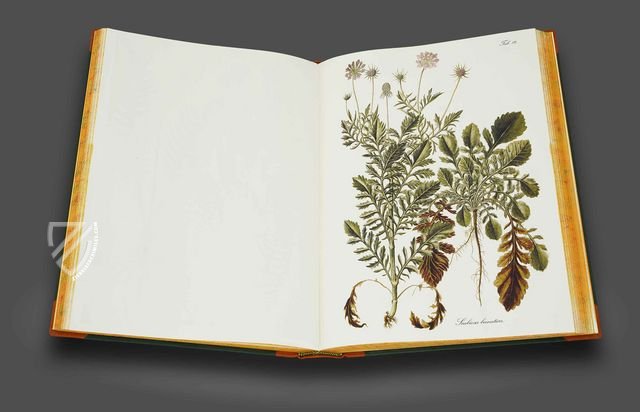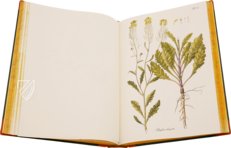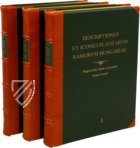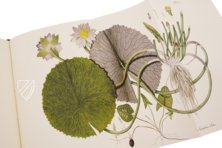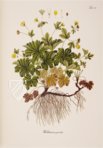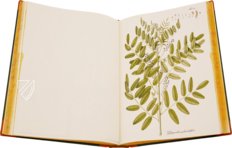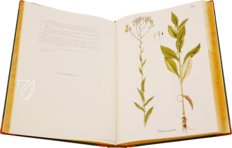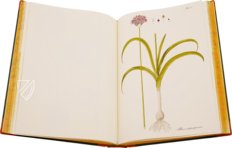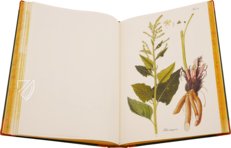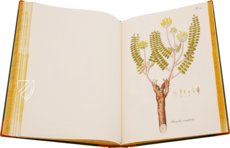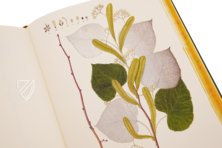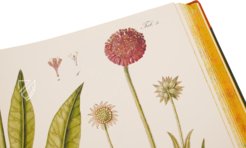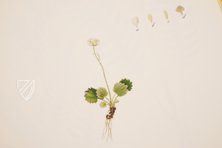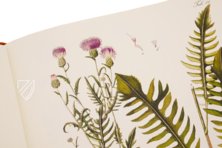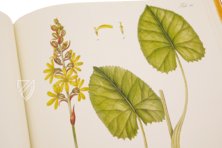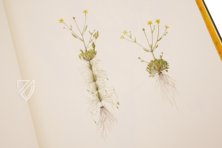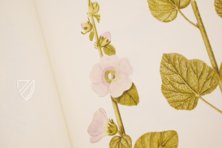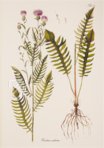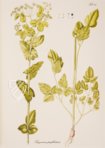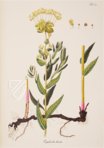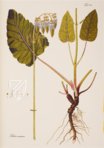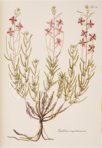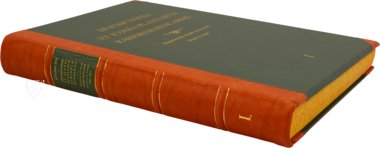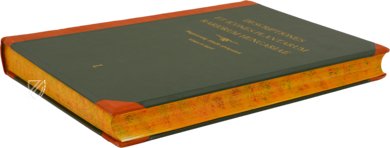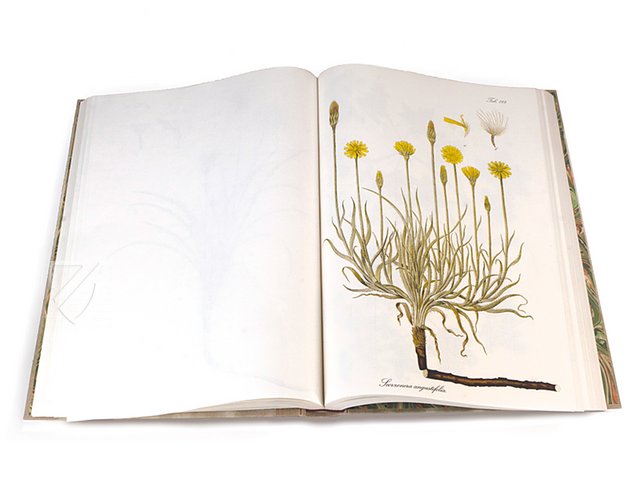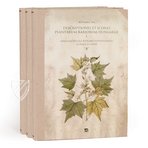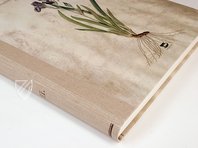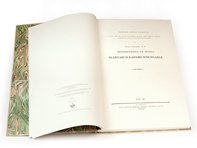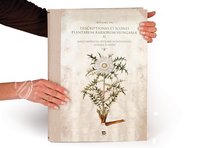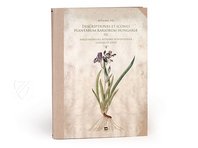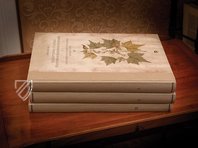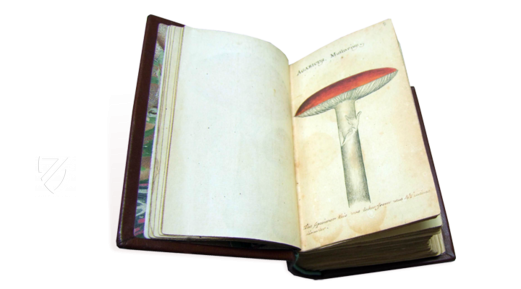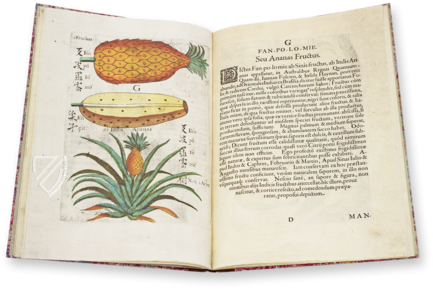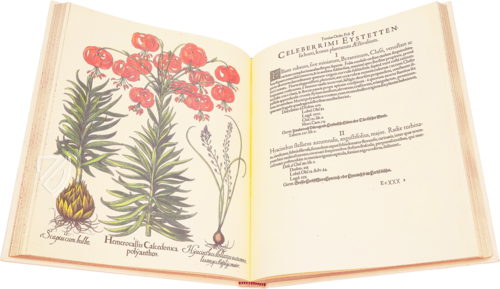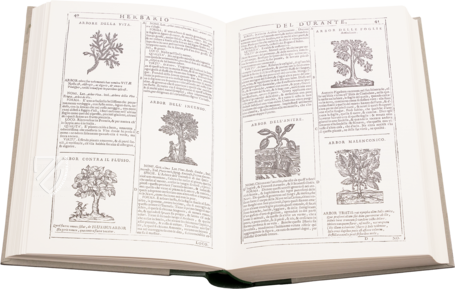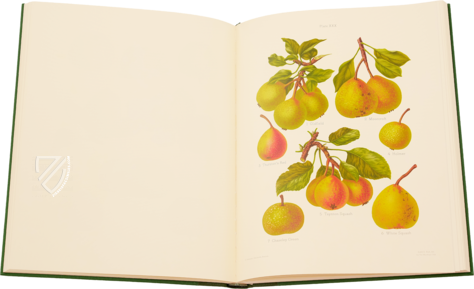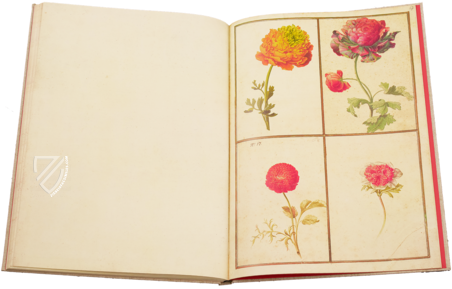Paul Kitaibel: Descriptiones Et Icones Plantarum Rariorum Hungariae
(1,000€ - 3,000€)
After a career in the Austrian Army, Count Franz von Waldstein (1759–1823) devoted himself to botany and commissioned one of the most important works of the emerging science: Descriptiones Et Icones Plantarum Rariorum Hungariae. Written by Paul Kitaibel (1757–1817), professor of botany at the University of Pest, its three volumes are a summation of his years of travel and observation throughout Hungary, Croatia, and adjoining regions. This important text is decorated with 280 colored engravings detailing the flora, fauna, minerals, and even folklore of the regions he visited.
Paul Kitaibel: Descriptiones Et Icones Plantarum Rariorum Hungariae
This collection of the plants and flowers of the Carpathian Basin is one of the most beautiful books of its type. Paul Kitaibel (1757–1817), the famous botanist made long journeys in the Carpathian Basin at the end of the 18th century. During these trips, he collected and described the different plants, rocks, and analyzed the mineral water as well. This work was the basis for the 3 volumes presented here in this richly illustrated album. It contains 280 beautifully hand-colored engraved plates of which 16 fold out. This is a fine, unabridged, and unusually fresh copy of the first (and only) edition of this monumental study of the flora of Hungary and adjacent territories, including Croatia, with splendid graphics in the Viennese ‘Jacquin’ style.
A Grand Botanical Research Project
The text is by Paul Kitaibel, professor of botany at the University of Pest. He spent much of his career roaming Hungary and collecting botanical, zoological, and mineralogical specimens as well as folklore. His collections of botanical and mineralogical specimens formed the basis for the natural history collection of the Hungarian National Museum. The work was financed by Count Franz Waldstein (1759–1823), an Austrian military leader who fought against the Turks in the Austro-Turkish War (1788–91), Russia, and various North African states as a Maltese knight. Beginning in 1789, he devoted himself to botany, travelling with Kitaibel through Hungary collecting plants, interspersed with military service. His herbarium is stored today in Prague. The water colors are signed by Hirscher and the plates are engraved by Karl Schutz after drawings by his son Johann.
Codicology
- Size / Format
- 3 volumes - 676 pages / 48.8 × 34.5 cm
- Origin
- Austria
- Date
- 1802–1812
- Epochs
- Style
- Language
- Illustrations
- 280 handcolored engraved plates
- Content
- Herbarium
- Patron
- Count Franz Waldstein (1759–1823)
- Artist / School
- Paul Kitaibel (1757–1817) (author)
Karl Schütz (engraver)
Johann Schütz (1755–1813) (illustrator)
Andreas Schmidt (printer)
Viennese ‘Jacquin’ style
Paul Kitaibel: Descriptiones Et Icones Plantarum Rariorum Hungariae
Salvia nutans
Commonly called “nodding sage” due to its drooping bunches of blue flowers, Salvia nutans, is indigenous to the meadows of Central and Eastern Europe with a range extending as far as Siberia. Although rarely used in European gardens as an ornamental plant, it was imported to North America due to its peculiar and interesting clusters of overhanging flowers. The plant has since gone “wild” and become naturalized in the states of Minnesota and New York.
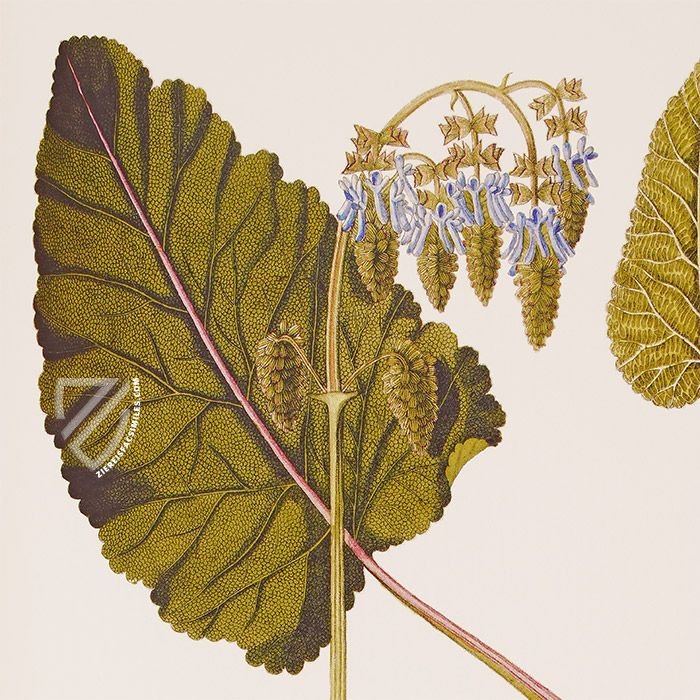
Paul Kitaibel: Descriptiones Et Icones Plantarum Rariorum Hungariae
Waldsteinia geoides
Waldsteinia is a genus of Rosaceae, the rose family, which appears in temperate regions of the northern hemisphere across the world. It is sometimes referred to as “barren strawberry” due to its appearance, especially when its yellow flowers are not in bloom. Thanks to its hearty root system, three varieties are cultivated as perennial ground cover in gardens in North America, Europe, and Asia, respectively.
The European variety, Waldsteinia geoides, is indigenous to the southeast of the continent and its range extends from Hungary and Croatia to the western regions of Ukraine. At the top of the page, the five stages of the plant’s flowering period, which occurs from April to May, is depicted in detail from bud to seed.
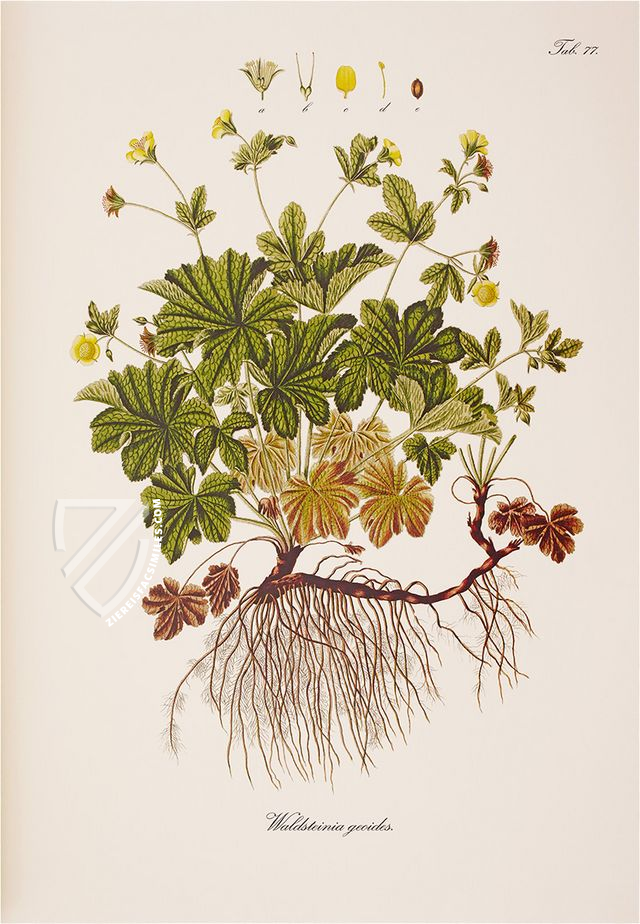
#1 Paul Kitaibel: Descriptiones Et Icones Plantarum Rariorum Hungariae
(1,000€ - 3,000€)
#2 Paul Kitaibel: Descriptiones Et Icones Plantarum Rariorum Hungariae
(1,000€ - 3,000€)
- Treatises / Secular Books
- Apocalypses / Beatus
- Astronomy / Astrology
- Bestiaries
- Bibles / Gospels
- Chronicles / History / Law
- Geography / Maps
- Saints' Lives
- Islam / Oriental
- Judaism / Hebrew
- Single Leaf Collections
- Leonardo da Vinci
- Literature / Poetry
- Liturgical Manuscripts
- Medicine / Botany / Alchemy
- Music
- Mythology / Prophecies
- Psalters
- Other Religious Books
- Games / Hunting
- Private Devotion Books
- Other Genres
- Afghanistan
- Armenia
- Austria
- Belgium
- Colombia
- Croatia
- Czech Republic
- Denmark
- Egypt
- Ethiopia
- France
- Germany
- Hungary
- India
- Iran
- Iraq
- Israel
- Italy
- Japan
- Luxembourg
- Mexico
- Morocco
- Netherlands
- Peru
- Poland
- Portugal
- Russia
- Serbia
- Spain
- Sri Lanka
- Sweden
- Switzerland
- Syria
- Turkey
- Ukraine
- United Kingdom
- United States
- Uzbekistan
- Aboca Museum
- Ajuntament de Valencia
- Akademie Verlag
- Akademische Druck- u. Verlagsanstalt (ADEVA)
- Aldo Ausilio Editore - Bottega d’Erasmo
- Alecto Historical Editions
- Alkuin Verlag
- Almqvist & Wiksell
- Amilcare Pizzi
- Andreas & Andreas Verlagsbuchhandlung
- Archa 90
- Archiv Verlag
- Archivi Edizioni
- Arnold Verlag
- ARS
- Ars Magna
- ArtCodex
- AyN Ediciones
- Azimuth Editions
- Badenia Verlag
- Bärenreiter-Verlag
- Belser Verlag
- Belser Verlag / WK Wertkontor
- Benziger Verlag
- Bernardinum Wydawnictwo
- BiblioGemma
- Biblioteca Apostolica Vaticana (Vaticanstadt, Vaticanstadt)
- Bibliotheca Palatina Faksimile Verlag
- Bibliotheca Rara
- Boydell & Brewer
- Bramante Edizioni
- Brepols Publishers
- British Library
- C. Weckesser
- Caixa Catalunya
- Canesi
- CAPSA, Ars Scriptoria
- Caratzas Brothers, Publishers
- Carus Verlag
- Circulo Cientifico
- Club Bibliófilo Versol
- Club du Livre
- CM Editores
- Collegium Graphicum
- Collezione Apocrifa Da Vinci
- Comissão Nacional para as Comemorações dos Descobrimentos Portugueses
- Coron Verlag
- Corvina
- CTHS
- D. S. Brewer
- De Agostini/UTET
- De Schutter
- Deuschle & Stemmle
- Deutscher Verlag für Kunstwissenschaft
- DIAMM
- Droz
- E. Schreiber Graphische Kunstanstalten
- Ediciones Boreal
- Ediciones Grial
- Ediclube
- Edições Inapa
- Edilan
- Editalia
- Edition Georg Popp
- Edition Leipzig
- Edition Libri Illustri
- Editiones Reales Sitios S. L.
- Éditions de l'Oiseau Lyre
- Editions Medicina Rara
- Editorial Casariego
- Editorial Mintzoa
- Editrice Antenore
- Editrice Velar
- Edizioni Edison
- Egeria, S.L.
- Eikon Editores
- Electa
- Enciclopèdia Catalana
- Eos-Verlag
- Ephesus Publishing
- Eugrammia Press
- Extraordinary Editions
- Fackelverlag
- Facsimila Art & Edition
- Facsimile Editions Ltd.
- Facsimilia Art & Edition Ebert KG
- Faksimile Verlag
- Feuermann Verlag
- Folger Shakespeare Library
- Franco Cosimo Panini Editore
- Friedrich Wittig Verlag
- Fundación Hullera Vasco-Leonesa
- G. Braziller
- Gabriele Mazzotta Editore
- Gebr. Mann Verlag
- Gesellschaft für graphische Industrie
- Getty Research Institute
- Giovanni Domenico de Rossi
- Giunti Editore
- Graffiti
- Grafica European Center of Fine Arts
- Guido Pressler
- Guillermo Blazquez
- H. N. Abrams
- Harrassowitz
- Helikon
- Hendrickson Publishers
- Henning Oppermann
- Herder Verlag
- Hes & De Graaf Publishers
- Hoepli
- Hortus Deliciarum
- Houghton Library
- Hugo Schmidt Verlag
- Idion Verlag
- Il Bulino, edizioni d'arte
- ILte
- Imago
- Insel Verlag
- Instituto de Estudios Altoaragoneses
- Instituto Nacional de Antropología e Historia
- Istituto dell'Enciclopedia Italiana - Treccani
- Istituto Ellenico di Studi Bizantini e Postbizantini
- Istituto Geografico De Agostini
- Istituto Poligrafico e Zecca dello Stato
- Italarte Art Establishments
- J. Thorbecke
- Jan Thorbecke Verlag
- Johnson Reprint Corporation
- Jugoslavija
- Karl W. Hiersemann
- Kasper Straube
- Kaydeda Ediciones
- Konrad Kölbl Verlag
- Kurt Wolff Verlag
- La Liberia dello Stato
- La Linea Editrice
- La Meta Editore
- Lambert Schneider
- Landeskreditbank Baden-Württemberg
- Leo S. Olschki
- Les Incunables
- Library of Congress
- Libreria Musicale Italiana
- Lichtdruck
- Lito Immagine Editore
- Lumen Artis
- Lund Humphries
- M. Moleiro Editor
- Maison des Sciences de l'homme et de la société de Poitiers
- Manuscriptum
- Maruzen-Yushodo Co. Ltd.
- MASA
- McGraw-Hill
- Militos
- Millennium Liber
- Müller & Schindler
- National Library of Wales
- Neri Pozza
- Nova Charta
- Oceanum Verlag
- Odeon
- Orbis Mediaevalis
- Orbis Pictus
- Österreichische Staatsdruckerei
- Oxford University Press
- Pageant Books
- Parzellers Buchverlag
- Patrimonio Ediciones
- Pattloch Verlag
- PIAF
- Pieper Verlag
- Plon-Nourrit et cie
- Prestel Verlag
- Princeton University Press
- Prisma Verlag
- Priuli & Verlucca, editori
- Pro Sport Verlag
- Propyläen Verlag
- Pytheas Books
- Quaternio Verlag Luzern
- Reales Sitios
- Recht-Verlag
- Reichert Verlag
- Reichsdruckerei
- Riehn & Reusch
- Roberto Vattori Editore
- Rosenkilde and Bagger
- Roxburghe Club
- Salerno Editrice
- Sarajevo Svjetlost
- Schöck ArtPrint Kft.
- Scolar Press
- Scrinium
- Scripta Maneant
- Scriptorium
- Siloé, arte y bibliofilia
- SISMEL - Edizioni del Galluzzo
- Sociedad Mexicana de Antropología
- Sorli Ediciones
- Stainer and Bell
- Styria Verlag
- Sumptibus Pragopress
- Szegedi Tudomànyegyetem
- Taberna Libraria
- Tarshish Books
- Taschen
- Tempus Libri
- Testimonio Compañía Editorial
- Thames and Hudson
- The Clear Vue Publishing Partnership Limited
- The Facsimile Codex
- The Folio Society
- The Marquess of Normanby
- The Richard III and Yorkist History Trust
- Tip.Le.Co
- TouchArt
- TREC Publishing House
- TRI Publishing Co.
- Trident Editore
- Typis Regiae Officinae Polygraphicae
- Universidad de Granada
- University of California Press
- University of Chicago Press
- Urs Graf
- Vallecchi
- Van Wijnen
- VCH, Acta Humaniora
- VDI Verlag
- Verlag für Regionalgeschichte
- Verlag Styria
- Vicent Garcia Editores
- W. Turnowsky
- Wiener Mechitharisten-Congregation (Wien, Österreich)
- Wissenschaftliche Buchgesellschaft
- Xuntanza Editorial
- Zollikofer AG

